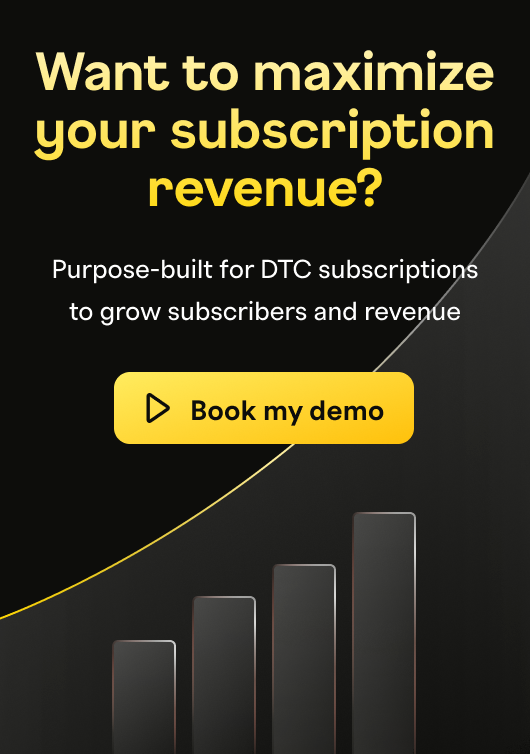Mixed cart checkout: Boost sales and delight customers

Customers today demand flexibility when shopping online. For subscription businesses, enabling a simplified purchase of both recurring and one-time products in a single transaction can be a big win for both customers and merchants. Mixed cart checkout enhances the customer experience, drives higher average order value (AOV), strengthens retention, and opens up diverse revenue opportunities.
In this article, we’ll explore how mixed cart checkout works, why it matters, and how Recurly makes it easy to implement.
💡 Key takeaways
Enhancing customer convenience: Mixed cart checkout simplifies the shopping experience, allowing customers to purchase multiple types of products together in one transaction
Boosting sales potential: Utilizing mixed carts allows businesses to effectively increase the average order value, driving greater revenue and customer engagement
Efficient integration is key: Implementing mixed cart checkout requires a modular tech stack to support a smooth experience for both shoppers and your operations
Getting the right combination: Successful mixed cart usage requires thoughtfully pairing one-time purchases with subscription products that genuinely resonate with your customers' needs and desires
What is mixed cart checkout?
Mixed cart checkout allows customers to combine one-time purchases and subscription-based products in the same shopping cart, completing their transaction in one simple process. So, what does this actually look like?
Meet Sarah: Sarah, a fitness enthusiast who frequents her local gym is looking to renew her monthly gym membership and purchase a single bag of protein powder from the gym’s online store.
Here’s how mixed cart checkout benefits her:
Sarah adds her monthly gym membership subscription to her shopping cart.
She then chooses a one-time purchase of her favorite protein powder.
At checkout, both items are consolidated into a single transaction, allowing her to pay for both simultaneously without needing separate orders.
This simplified process saves Sarah time and effort while enhancing her shopping experience, and earned the gym a bump in revenue.
The business case for mixed cart usage
The many benefits of offering mixed cart support - for both shoppers and merchants - make it a winning ecommerce tactic worth exploring.
1. Increased average order value (AOV)
Mixed carts are a powerful way to boost sales by encouraging customers to add high-margin or additional items to their orders. This strategy uses upselling and cross-selling techniques to boost revenue, whether through subscriptions or one-time purchases.
Why it works:
8 in 10 consumers say personalized offers like discounts or bundles strongly influence their buying decisions (Deloitte)
Mixed cart checkout doesn’t just raise the average order value — it creates a better customer experience by providing convenient product combinations in one transaction
2. Try before you buy
For many customers, trying a product before committing to yet another subscription is an appealing prospect. Mixed cart functionality makes this concept easy and attractive. Customers can add items to their subscription as one-time purchases before fully diving in. This “try-and-see” model allows subscribers to test new products risk-free — turning impulse add-ons into essential parts of their routine. Mixed cart also allows users to take advantage of trials for subscriptions.
Critically, this allows your business to test new product offerings, give customers the chance to try products risk free before subscriptions, and build loyalty quickly with customers.
3. Diversified revenue streams
Ecommerce businesses relying solely on one-time purchases or subscriptions often face seasonal revenue volatility. Incorporating both options with mixed cart checkout allows businesses to smooth out revenue dips and create more predictable growth over time.
4. Increase customer loyalty
Customers want a quick, stress-free shopping experience. Mixed cart checkouts allow them to buy single items and subscriptions in one go, which leads to reduced cart abandonment, and increased loyalty. Customers are more likely to stick with a business that provides them an easy and simple checkout process.
Mixed cart functionality gives you the flexibility to provide customers with more options while keeping their buying process easy and efficient.
How it works in action
FabFitFun and Dollar Shave Club have mastered the art of using mixed cart functionality to boost both revenue and customer engagement. By seamlessly offering exclusive one-time products alongside their subscriptions, they create a smooth, hassle-free shopping experience that encourages customers to add more to their carts. This strategy not only enhances the customer experience but also drives significant upselling opportunities. Here’s how:
💡FabFitFun blending subscriptions and add-ons
The challenge: FabFitFun’s seasonal boxes led to periods of inconsistent customer engagement, but how could they counteract this cycle of high and low engagement?
The solution: They introduced “add-ons” — discounted products members could include in their next box with no extra shipping fees

This process, designed to boost engagement, also aligns with one of FabFitFun’s core principles: a customer-centric approach to everything they do. By delivering added value to their customers, they not only enhance the user experience, but also foster lasting loyalty. When executed properly, businesses can deliver greater value while diversifying their income, See how FabFitFun was able to enhance their customer experience and tackle involuntary churn with Recurly.
💡Dollar Shave Club's approach to mixed carts
Dollar Shave Club mastered the mixed cart model by providing a robust ecommerce subscription service with one-time products that their customers need.
Smart suggestions: At checkout, the brand recommends complementary products — think travel cases, aftershave bundles, or grooming essentials
Increased value: This strategy boosts average order value while delivering a seamless, personalized shopping experience
The result? Convenience for customers, better sales for the business — a true win-win.
Challenges of implementing mixed cart checkouts
While the benefits of mixed carts are undeniable, integrating this functionality successfully comes with its challenges.
1. Creating a simple checkout experience
A seamless checkout for mixed carts is a major challenge for ecommerce businesses. The stakes are high: 22% of users abandon carts due to long and complicated checkouts, according to the Baymard Institute. Oftentimes companies are stuck with:
Homegrown solutions that don’t scale
Siloed technology
Security issues handling payments
To succeed, you need a tech stack that handles different product types, plan options, discounts, and payment methods securely and smoothly. We’ll touch on how to achieve this down below.
2. Choosing the right pricing plans
Offering the right subscription options can make all the difference in driving signups and boosting customer lifetime value (LTV).
Why it matters:
71% of merchants now offer both monthly and annual plans to meet growing demand for flexibility (Recurly). Consumers want this flexibility, and your shopping cart needs it.
Providing multiple plan options directly in your shopping cart makes it easier for customers to commit, increasing conversions and improving retention.
PupBox, a leading provider of puppy products, identified the importance of offering flexible billing options for pet parents. By introducing both monthly and yearly subscription plans, they successfully reduced churn and increased customer lifetime value (LTV). These flexible options not only empower customers with greater choice but also strengthen PupBox’s bottom line, creating a win-win for both the brand and its audience.
Find out how they did this: PupBox expands subscriber base with flexible billing from Recurly
3. Knowing your audience
Every customer base is unique. While some audiences may value subscriptions for everyday essentials, others might prefer to make sporadic, one-off purchases. Conduct customer surveys, analyze purchasing data, and beta-test product offerings to find the right balance.
What you’ll need for mixed cart success
Implementing mixed cart checkouts requires the right technology, insights, and strategy. Here’s what to focus on:
1. A flexible tech stack
To successfully sell subscriptions and one-time purchases, ecommerce businesses need a modular tech stack. This allows them to combine technology to make for a better customer experience. Here's how to achieve it:
Leverage composable commerce: This tech approach is about integrating modular solutions across platforms, ensuring seamless data transfer for both businesses and consumers
Focus on flexibility: Composable solutions make it easier to test, optimize, and improve mixed cart features
Consider no-code solutions: No-code solutions allow you to move quickly with your ecommerce platform, integrating with other systems to move at the speed of the market
Scalability: Choose solutions designed to grow with your business and handle increasing transaction volumes
Streamlined billing: The right solution should make payments easy for customers while simplifying financial management for staff
The right tech integration can save time, money, and resources you would normally spend on billing and managing your tech stack.
2. Smart product pairings
Mixed carts provide invaluable insights into customer preferences. By tracking how often products are purchased as one-time buys versus subscriptions, you can refine your offerings. You can then use this data to introduce new bundles, optimize pricing strategies, and identify which products resonate most with your audience.
Consider your bundle type
However, the right product pairing isn’t enough — you need the right bundle strategy to maximize revenue. There are several options to consider:
Pure bundles
Mixed bundles
Buy-more-pay-less bundles
Upsells bundles
What does this look like in action? Here’s Canary in action combining their best-selling camera with a digital subscription storage solution. Notice how each bundle option offers different features, optimizes for different payment strategies, and gives clear direction for the consumer.

They’ve hit multiple buyers with these bundles:
Buyers who prefer to own the device and receive basic alerts
Buyers who opt for a subscription to access all camera features without ownership
Buyers who want to own the camera outright and enjoy full subscription features with no contract
Learn more about testing and iteration here: Subscription pricing & packaging
3. Incentives to build loyalty
Customers need a reason to try a subscription. Offering discounts for bundles or free shipping after spending a certain amount can turn one-time buyers into subscribers. Including loyalty incentives can boost retention over time.
Want to know what incentives keep subscribers around for the long haul? Check out our industry leading report: 2025 State of Subscriptions.
4. Tap into post-purchase power
Allow flexibility for customers to add to their order after checkout. By enabling post-purchase upsells when buyer sentiment is high, you can further boost your AOV without disrupting the customer experience.
5. Strategies to ensure mixed cart success
While mixed cart checkout is a necessity for most ecommerce businesses, that doesn’t mean it will automatically be successful.
Highlight the benefits: Use banners, pop-ups, or product descriptions to show how combining one-time purchases with subscriptions offers convenience, savings, and flexibility
Optimize product pages: Ensure product pages clearly showcase both one-time purchase and subscription options with intuitive design and clear descriptions
Leverage email campaigns: Send personalized emails that promote your mixed cart features, explain their benefits, and highlight how they simplify checkout
Use social proof: Feature reviews and testimonials from satisfied customers who enjoy the convenience of mixed carts
Incentivize with promotions: Offer introductory coupons, limited-time discounts, or exclusive perks like free shipping to encourage customers to try combining purchase types
Educate your audience: Create content like blogs, videos, or FAQs that explain how mixed carts work and why they’re valuable
Ready for mixed cart checkout for your Shopify store?
Looking for a no-code solution to manage your Shopify subscriptions and drive growth? Recurly’s Shopify app empowers you to create the perfect tech stack to accelerate your success with ease.
Find out more at Recurly for Shopify.

